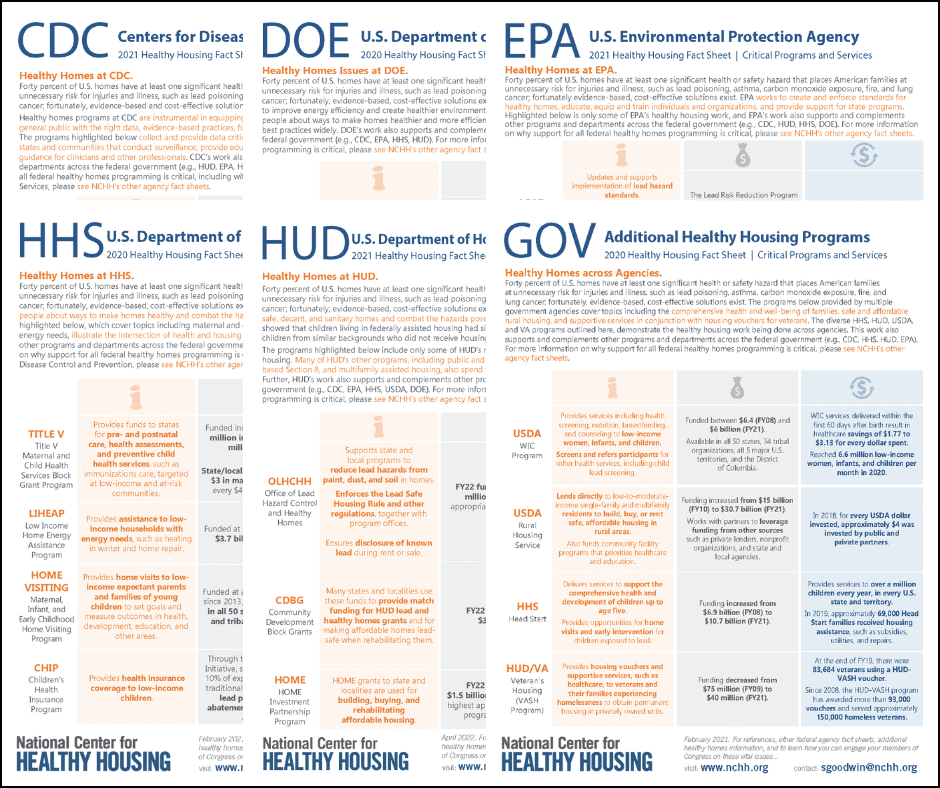Healthy Housing Agency Fact Sheets
Forty percent (40%) of homes in the United States have at least one significant health or safety hazard that places families at unnecessary risk for injuries and illness, such as lead poisoning, asthma, carbon monoxide exposure, fire, and lung cancer; fortunately, evidence-based and cost-effective solutions exist.
A wide range of programs across federal agencies work together to create healthier home environments and reduce the burden of housing-related illness and injury.
- At the Centers for Disease Control and Prevention (CDC), healthy homes programs are instrumental in equipping states, communities, decision makers, and the general public with the right data, evidence-based practices, funding, and information to improve health outcomes. CDC collects and provides data critical to screening and prevention efforts; supports states and communities conducting surveillance, provides education, and coordinates services; and provides guidance for clinicians and other professionals.
- Healthy homes programs at the Department of Energy (DOE) are focused on improving energy efficiency and healthier environments by educating homeowners safe best practices and encouraging developing innovative solutions to reduce energy waste. There are incentive programs in place to connect homeowners with contractors to assess the energy expenditure, quality, and affordability of their homes.
- Healthy homes programs at the Environmental Protection Agency (EPA) work to create and enforce standards for healthy homes, educate, equip, and train both individuals and organizations and provide support for state programs.
- Healthy homes programs at the Department of Health and Human Services (HHS) teach Americans how to make homes healthy and combat the hazards posed by unhealthy housing. Their programs cover topics including maternal and child healthcare, home visiting services, and home energy needs, illustrating the intersection of health and housing issues.
- Healthy homes programs at the Department of Housing and Urban Development (HUD) work to provide safe, decent, and sanitary homes, fighting hazards posed by unhealthy housing. Many of HUD’s other programs, including public and tribal housing, the Federal Housing Authority, project-based Section 8, and multifamily assisted housing also spend funds on lead hazard identification and control.
- Healthy homes programs at the collection of government programs are aimed to cover topics such as the comprehensive health and well-being of families, safe and affordable rural housing, and supportive services in conjunction with housing vouchers for veterans. These programs include the U.S. Department of Agriculture’s WIC Program, U.S Department of Agriculture’s Rural Housing Service, The Office of Head Start, and U.S. Department of Housing and Urban Development’s Veteran Housing Program.
Each respective agency’s work both supports and complements other programs and departments across the federal government.
With generous funding from the Kresge Foundation, this series was originally published by NCHH in June 2018, and a second series (which added two new fact sheets) was released in October 2019. These agency fact sheets were designed to share information about the following:
- Why the agency is important to healthy homes activities
- Which specific programs are most relevant and their program activities
- The current/historical funding numbers
- The impact or return on investment
See NCHH’s agency fact sheets below for more information on why support for all federal healthy homes programming is critically important.
Centers for Disease Control and Prevention (CDC)
Environmental Protection Agency (EPA)
Department of Health and Human Services (HHS)
Department of Housing and Urban Development (HUD)
Additional Healthy Housing Programs
Download the full suite of Healthy Housing Agency fact sheets here.
Additional Resources
NCHH strives to update the agency fact sheets whenever new information becomes available. Full bundles of current and past agency fact sheets are available below.
- The 2020-22 agency fact sheets bundle.
- The 2019 agency fact sheets bundle.
- The 2018 agency fact sheets bundle.
Related
Blogs analyzing the president’s annual proposed budget are collected here:
Latest page update: November 7, 2023.
